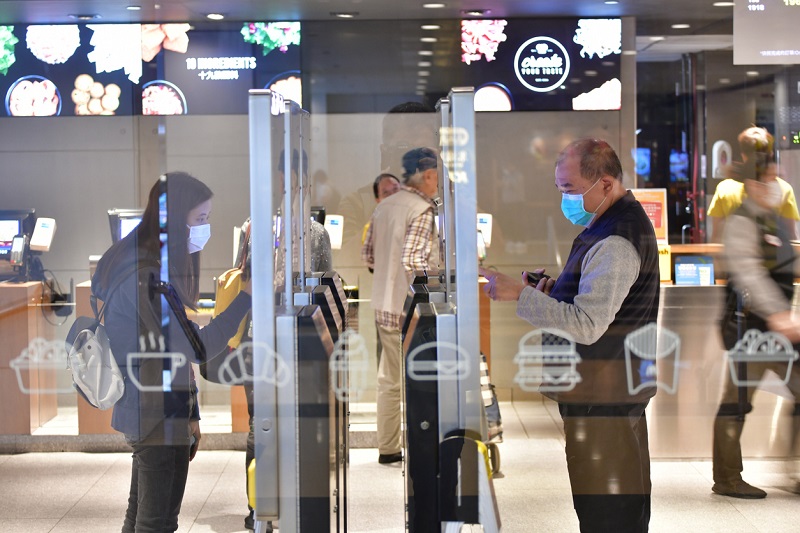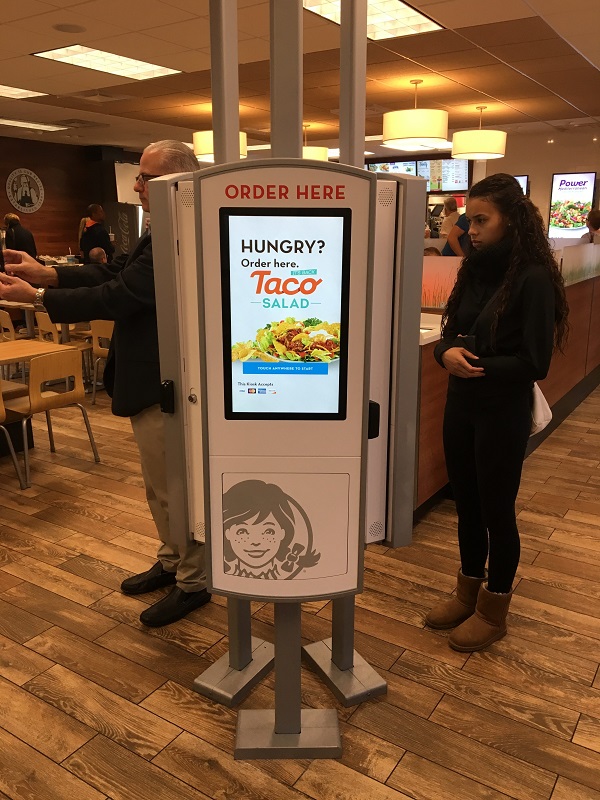A kiosk ordering system allows contact-free ordering for customers that is easy and convenient to use. Kiosk systems have grown tremendously in popularity due to the demand for more automated ordering that is also safe and convenient.
Parts of a kiosk ordering system
A kiosk ordering system comprises four essential pieces: the enclosure, the software, the display, and the integrations/components that allow it to handle specific processes.
- Enclosure: This is the “skeleton” of the system which houses the display and various components such as keypads, credit card readers, and bill collectors.
- Software: Software is the brain of the kiosk, which is what tells the components and display how to function together to complete various operations, such as processing payments or mapping a location.
- Display: A digital screen that can be static, interactive, or non-touch. For ordering kiosks, the display would almost always be interactive with touchscreen functionality.
- Components & Integrations: These are parts that allow physical functionality, such as payments to be made via bill collection or credit card reader, or tickets and receipts to be printed.
Who uses kiosk ordering systems?
Kiosk ordering systems are designed to provide a convenient, easy-to-use option for customers who wish to order food without employee assistance.
- Restaurants: Food ordering kiosks provide fast casual and sit-down restaurants with the option to offer guests a way to order without the assistance of a server. Sit-down restaurants generally utilize hand-held tablets that allow guests to order food at their own leisure. This decreases the amount of necessary servers which allows restaurant staff to handle more concerns that cannot be automated, such as drink refills, delivering orders to tables, and handling customer service.
- Fast Food/QSR: Fast food (also known as “quick service” or “QSRs) and fast casual restaurants utilize ordering kiosks that allow guests to order at the front of the restaurant, before taking a seat. This can cut down on wait times and offer faster service by sending orders directly to the kitchen. It can also create more accurate orders, as guests input their choices directly, rather than going through a third party.

Benefits of a kiosk ordering system
A kiosk ordering system provides restaurants with some key benefits, including:
- Lower overhead: By automating ordering, restaurants require fewer staff to assist customers.
- Better/faster customer service: Automated ordering creates efficiencies that free up existing staff to care for customers’ more immediate concerns such as menu questions or other customer service issues.
- Social distancing: COVID-19 created a need for greater social distancing. But as the pandemic recedes, it’s clear that it’s become the desire of many to keep some of these automated, contact-free experiences in place for the sake of efficiency as well as safety.
Examples of major fast companies using order systems
Many companies combine drive-through service with automated kiosks to help expedite the ordering process by serving large volumes of customers at a time, especially during peak times, such as before the typical workday and at the lunch hour. Customers can simply walk in, create their order using the touch-screen, and pick it up at the counter when it is ready. The fast food companies listed below already successfully use self-ordering systems:
- Mcdonalds
- Wendys
- Burger King
- Jack-in-the-Box
- Panera
- Subway
- Taco Bell

How kiosk ordering systems work
Setting up a self-service restaurant kiosk is not nearly as complicated as many might believe. Here is how to get started:
- Purchasing a kiosk
The most important step is finding a trusted kiosk manufacturer that will suit your needs. Kiosks come in many shapes, sizes and functions, so it is key that you find a manufacturer that understands your specific needs and is able to construct a kiosk for this purpose.
2) Kiosk setup
Once the kiosk has been manufactured a reputable kiosk manufacturer will offer white-glove delivery as well as on-site assistance to help get the kiosk up and running smoothly at the intended location. They will not only help install the kiosk, but also ensure that the software is functioning properly.
3) Using the kiosk system
Once the kiosk is fully operational, it can now begin processing orders. A user inputs their order and it is displayed and processed through the kiosk system. The kiosks offer a wide variety of ordering options, allowing the customer to customize their order to their exact specifications.
4) Order is sent to the kitchen
Once the order has been placed, it is processed by the kitchen staff. They are then able to prepare the food to the exact specifications of the customer, decreasing the likelihood of incorrect orders.
5) Food is delivered
Once the order has been prepared, it is ready for the customer. The entire process is streamlined in a way that is more convenient and efficient for both the customer and the restaurant, providing a better overall customer experience.
In summary, kiosk ordering systems provide the food industry with an incredible asset. They drastically improve customer satisfaction and decrease overhead while offering greater efficiency, productivity and a better user experience. Given the many positives, it is easy to see why more and more restaurants are adopting kiosk ordering systems.


